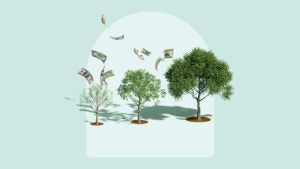Survey: Two-thirds of savers still earn a savings account APY of less than 4%

A high-yield savings account provides multiple benefits: You have easy access to your funds, and your money is likely earning a rate that’s outpacing inflation. These days, many banks offer a high-yield savings account with an annual percentage yield (APY) above 4 percent, although two-thirds of Americans (67 percent) with savings are earning a lower rate than this, Bankrate’s latest online savings survey found.
Consumers looking for savings accounts that earn APYs of 4 percent or higher are most likely to find them at online banks, whereas many of the nation’s largest banks offer significantly lower APYs of only around 0.01 percent.
While it’s not difficult to find a savings account that pays a competitive APY, only 22 percent of Americans with savings are earning an APY of 4 percent or more, Bankrate’s survey found. Many savers are earning lower APYs, while others have reported earning no interest. One-third (33 percent) reported not having any short-term savings.
Slightly more than half of savers (51 percent) reported having a savings or money market account with an online bank — which is up from 40 percent last year. Among savers who don’t have such an account, top reasons listed were preference for access to a local branch (45 percent), comfort level with their current financial institution (42 percent) and worries about the security of their money (32 percent).
Despite widespread availability of higher returns on federally insured accounts with little or no minimum deposit requirement, two-thirds of savers are earning less than 4 percent on their emergency savings.— Greg McBride, CFA | Bankrate Chief Financial Analyst
Key statistics on high-yield savings
- Of Americans with short-term savings, just 15% are earning between 4% and 4.99% APY, while only an additional 7% are earning an APY of 5% or higher.
- 1 in 10 savers (10%) earns an APY between 3% and 3.99%, while 22% earn 1% to 2.99% APY and 17% earn some interest but less than 1% APY. Around 1 in 6 savers (17%) aren’t earning interest on their short-term savings, while 11% don’t know what, if any, interest they’re earning.
- Just over half (51%) of consumers have a savings or money market account with an online bank. Among those who don’t, 45% say it’s because they prefer access to a local branch, while 42% say it’s due to being comfortable with their current financial institution.
Most savers don’t earn competitive savings account rates
Bankrate’s survey asked consumers with short-term savings what rate of return their savings account is earning, with respondents choosing from among a series of APY ranges.
Notably, more than 1 in 5 savers (22 percent) are earning mediocre rates between 1 percent and 2.99 percent APY. In all, those with short-term savings reported earning the following rates:
- 7% of savers are earning 5% APY or higher
- 15% of savers are earning 4%-4.99% APY
- 10% of savers are earning 3%-3.99% APY
- 22% of savers are earning 1%-2.99% APY
- 17% of savers are earning less than 1% APY
- 17% of savers aren’t earning any interest
- 11% of savers are unsure of what APY they’re earning
While only 22 percent of savers reported earning 4 percent APY or higher, this figure reflects a significant increase from last year, when only 7 percent were earning such a yield.
Gender-wise, men are more likely than women (53 percent vs. 48 percent, respectively) to have a savings or money market account with an online bank. Similarly, men (26 percent) are more likely than women (19 percent) to be earning 4 percent APY or higher on their savings.
“Although plenty of savers have benefitted from rising interest rates with the percentage of savers earning at least 4 percent having tripled from one year ago, millions of Americans still need to get on board,” McBride says.
Millennials more likely to earn high APYs than other generations
Like last year, millennials are the group most likely to have a savings account that earns 4 percent APY or higher. The group least likely to earn at least 4 percent APY is Generation Z, despite the fact that two-thirds of Gen Zers (67 percent) have an account with an online bank. The percentage of each generation earning 4 percent or greater on a savings account is:
- Generation Z (ages 18-27): 20%
- Millennials (ages 28-43): 25%
- Generation X (ages 44-59): 21%
- Baby boomers (ages 60-78): 22%
Likelihood of earning a high APY increases with income
The likelihood of earning at least 4 percent on savings increases with annual income, as follows:
- Households earning less than $50,000: 17%
- Households earning $50,000-$79,999: 20%
- Households earning $80,000-$99,999: 25%
- Households earning $100,000 or more: 33%
Similarly, the likelihood of not earning any interest on savings is highest (26 percent) among the lowest household income group (earning under $50,000), but just 9 percent for households making $100,000 or more.
Separately, one-third (33 percent) of those surveyed said they have no emergency or short-term savings, a figure that remains the same as last year.
Reasons people don’t have online high-yield savings accounts
Just more than half of savers (51 percent) said they have a savings or money market account with an online bank, reflecting an increase from the 40 percent who reported that a year ago. Among those who don’t have an online bank account, the top reasons cited were preference for branch access, comfort with their current financial institution, and worries about the security of their money.
People with short-term savings who don’t have an online savings or money market account cited various reasons for this:
- Preferred access to a local branch: 45%
- Comfort level with current financial institution: 42%
- Worry about the security of their money: 32%
- Not enough savings to make it worthwhile: 22%
- Uncertainty about ease and speed of money transfer: 13%
- Haven’t gotten around to it: 10%
- The time and effort it takes to open account: 5%
- Something else 5%
- Don’t know 5%
“The most commonly cited reasons for not having an online savings or money market account are really excuses more than valid reasons,” McBride says. “The preference for a local branch or comfort level with the current financial institution can both remain intact, as only your savings account — nothing else — can be moved to an online bank to earn a higher rate of return. The online account is then linked to your present financial institution where the rest of your accounts remain.”
Bank branch preference across generations
In Bankrate’s survey, a desire for local branch access was the top reason people cited for not having an online bank account — and older generations were more likely to list this as a reason. Among those who have short-term savings but who don’t have an online account, the percentage of each generation who cited branch access as a reason is as follows:
- Generation Z: 32%
- Millennials: 36%
- Generation X: 43%
- Baby boomers: 53%
How to find the best high-yield savings account for you
When looking for the best savings account for you, take the time to shop around to compare rates, and also evaluate accounts based on fees they charge and any minimum deposit requirements.
APY: You can earn hundreds, even thousands, in interest over the years by picking a savings account that earns a competitive rate of return. These days, it’s not difficult to find a high-yield savings account that earns an APY that’s outpacing the rate of inflation.
Minimum opening deposit: While some savings accounts don’t have any minimum deposit requirement, others may require $25, $100 or even $1,000. When shopping around, look for an account that requires no minimum deposit amount — or a minimum that you’re comfortable with.
Monthly service fees: It’s not difficult to find a savings account that doesn’t charge any monthly service fees, although some accounts do charge such a fee if you don’t maintain a set minimum balance. It’s worth finding an account that won’t charge such a fee that eats into your savings.
Deposit insurance: When choosing a savings account, look for a bank or a credit union that insures deposits through the Federal Deposit Insurance Corp. (FDIC) or the National Credit Union Administration (NCUA). When institutions are covered by this federal insurance, deposit accounts are insured for up to $250,000 per depositor, per insured bank or credit union, for each account ownership category.
-
Bankrate commissioned YouGov Plc to conduct the survey. All figures, unless otherwise stated, are from YouGov Plc. The total sample size was 3,581 U.S. adults, including 2,406 who have short-term savings. Fieldwork was undertaken between February 20-23, 2024. The survey was carried out online and meets rigorous quality standards. It employed a non-probability-based sample using both quotas upfront during collection and then a weighting scheme on the back end designed and proven to provide nationally representative results.
You may also like

Why more older Americans are taking on student loan debt





